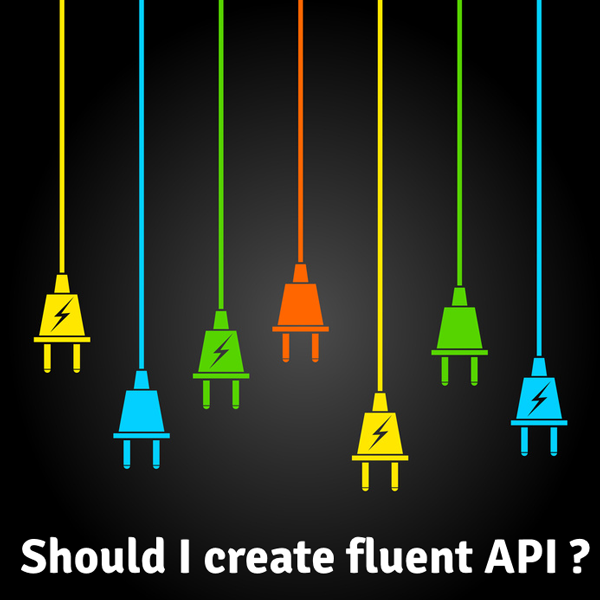JavaScript: Mastering the Art of Fluent APIs
When designing Babylon.js v2.0 (a library for building 3D on the web), I recently found myself wishing for more APIfluent - That said, I want it to be easier for the community to read, Understand and build on your work while spending less time on technical documentation.
In this tutorial, I’ll cover fluent APIs: what to consider, how to Writing them, and the cross-browser performance impact.
What is Fluent API?

The fluent API, as described in this Wikipedia article, is Object-oriented API designed to provide more readable code. JQuery is a great example of what a fluent API allows you to do:
$('<div></div>')
.html("Fluent API are cool!")
.addClass("header")
.appendTo("body");
Smooth API allows you to link The function is called by returning this object.
We can easily create one Fluent API like this:
var MyClass = function(a) {
this.a = a;
}
MyClass.prototype.foo = function(b) {
// Do some complex work
this.a += Math.cos(b);
return this;
}
As you can see, the trick
Just returns the this object (referencing the current instance
in this case) to allow the chain to continue.
If you don’t know How the "this" keyword works in JavaScript, I recommend reading this great article Author of the article: Mike West.
Then we can chain calls:
var obj = new MyClass(5); obj.foo(1).foo(2).foo(3);
Before trying to do the following Same as Babylon.js, I want to make sure this doesn't generate some Performance issues.
How is the performance?
So I did a benchmark test!
var count = 10000000;
var MyClass = function(a) {
this.a = a;
}
MyClass.prototype.foo = function(b) {
// Do some complex work
this.a += Math.cos(b);
return this;
}
MyClass.prototype.foo2 = function (b) {
// Do some complex work
this.a += Math.cos(b);
}
var start = new Date().getTime();
var obj = new MyClass(5);
obj.foo(1).foo(2).foo(3);
for (var index = 0; index < count; index++) {
obj.foo(1).foo(2).foo(3);
}
var end = new Date().getTime();
var start2 = new Date().getTime();
var obj2 = new MyClass(5);
for (var index = 0; index < count; index++) {
obj2.foo2(1);
obj2.foo2(2);
obj2.foo2(3);
}
var end2 = new Date().getTime();
var div = document.getElementById("results");
div.innerHTML += obj.a + ": With return this: " + (end - start) + "ms<BR>";
div.innerHTML += obj2.a + ": Without return this: " + (end2 - start2) + "ms";
as
You can see that foo and foo2 do exactly the same thing. only
The difference is that foo can be linked, while foo2 cannot.
Obviously the call chain The difference is:
obj.foo(1).foo(2).foo(3);
and
obj2.foo2(1); obj2.foo2(2); obj2.foo2(3);
Given this code, I ran it Find out if I care on Chrome, Firefox and IE performance.

This is the result I get:
- On Chrome, the regular API is 6% slower than the Fluent API.
- On Firefox, Both APIs run almost identically (Fluent API is 1% slower).
- On IE, Both APIs run almost identically (Fluent API is 2% slower).
The problem is that I added an operation in the function (Math.cos)
Simulates some kind of processing done by a function.
If I delete everything
Just keep the return statement, it doesn't work on all browsers
The difference (actually only one to two milliseconds over 10,000,000 attempts). you
You can test it yourself across browsers. if you don't have
The device is convenient and there are many free tools on dev.modern.IE. Just don’t perform performance testing on virtual machines
For real devices.
So my conclusion is: come on!
The fluent API is great - it produces more readable code, and you can use it without any issues or performance loss!
More practices JavaScript
This may surprise you a little, but Microsoft There is a lot of free learning content on many open source JavaScript topics, and we are With the arrival of Microsoft Edge, our mission is to create more. Check out my own:
- Introduction to 3D using HTML5 and WebGL Babylon.JS
- Build a single page application using the following commands ASP.NET and AngularJS
- Cutting-edge graphics in HTML
Or our team’s learning series:
- Practical performance tips to make your HTML/JavaScript Faster (a seven-part series from responsive design to Casual games to performance optimization)
- Quick Start with Modern Network Platforms (Basics HTML, CSS and JavaScript)
- Develop universal Windows applications HTML and JavaScript Jump Start (using the JS you've already created Build an application)
Plus some free tools: Visual Studio Community, Azure Trial, and cross-browser testing tools for Mac, Linux, or Windows Windows.
This article is part of network development technology Series from Microsoft. We're excited to share with you Microsoft Edge and the new EdgeHTML rendering engine. free Virtual machine or remote testing on Mac, iOS, Android or Windows devices @http://dev.modern.ie/.
The above is the detailed content of JavaScript: Mastering the Art of Fluent APIs. For more information, please follow other related articles on the PHP Chinese website!

Hot AI Tools

Undresser.AI Undress
AI-powered app for creating realistic nude photos

AI Clothes Remover
Online AI tool for removing clothes from photos.

Undress AI Tool
Undress images for free

Clothoff.io
AI clothes remover

AI Hentai Generator
Generate AI Hentai for free.

Hot Article

Hot Tools

Notepad++7.3.1
Easy-to-use and free code editor

SublimeText3 Chinese version
Chinese version, very easy to use

Zend Studio 13.0.1
Powerful PHP integrated development environment

Dreamweaver CS6
Visual web development tools

SublimeText3 Mac version
God-level code editing software (SublimeText3)

Hot Topics
 Replace String Characters in JavaScript
Mar 11, 2025 am 12:07 AM
Replace String Characters in JavaScript
Mar 11, 2025 am 12:07 AM
Detailed explanation of JavaScript string replacement method and FAQ This article will explore two ways to replace string characters in JavaScript: internal JavaScript code and internal HTML for web pages. Replace string inside JavaScript code The most direct way is to use the replace() method: str = str.replace("find","replace"); This method replaces only the first match. To replace all matches, use a regular expression and add the global flag g: str = str.replace(/fi
 Build Your Own AJAX Web Applications
Mar 09, 2025 am 12:11 AM
Build Your Own AJAX Web Applications
Mar 09, 2025 am 12:11 AM
So here you are, ready to learn all about this thing called AJAX. But, what exactly is it? The term AJAX refers to a loose grouping of technologies that are used to create dynamic, interactive web content. The term AJAX, originally coined by Jesse J
 10 jQuery Fun and Games Plugins
Mar 08, 2025 am 12:42 AM
10 jQuery Fun and Games Plugins
Mar 08, 2025 am 12:42 AM
10 fun jQuery game plugins to make your website more attractive and enhance user stickiness! While Flash is still the best software for developing casual web games, jQuery can also create surprising effects, and while not comparable to pure action Flash games, in some cases you can also have unexpected fun in your browser. jQuery tic toe game The "Hello world" of game programming now has a jQuery version. Source code jQuery Crazy Word Composition Game This is a fill-in-the-blank game, and it can produce some weird results due to not knowing the context of the word. Source code jQuery mine sweeping game
 How do I create and publish my own JavaScript libraries?
Mar 18, 2025 pm 03:12 PM
How do I create and publish my own JavaScript libraries?
Mar 18, 2025 pm 03:12 PM
Article discusses creating, publishing, and maintaining JavaScript libraries, focusing on planning, development, testing, documentation, and promotion strategies.
 jQuery Parallax Tutorial - Animated Header Background
Mar 08, 2025 am 12:39 AM
jQuery Parallax Tutorial - Animated Header Background
Mar 08, 2025 am 12:39 AM
This tutorial demonstrates how to create a captivating parallax background effect using jQuery. We'll build a header banner with layered images that create a stunning visual depth. The updated plugin works with jQuery 1.6.4 and later. Download the
 Auto Refresh Div Content Using jQuery and AJAX
Mar 08, 2025 am 12:58 AM
Auto Refresh Div Content Using jQuery and AJAX
Mar 08, 2025 am 12:58 AM
This article demonstrates how to automatically refresh a div's content every 5 seconds using jQuery and AJAX. The example fetches and displays the latest blog posts from an RSS feed, along with the last refresh timestamp. A loading image is optiona
 Getting Started With Matter.js: Introduction
Mar 08, 2025 am 12:53 AM
Getting Started With Matter.js: Introduction
Mar 08, 2025 am 12:53 AM
Matter.js is a 2D rigid body physics engine written in JavaScript. This library can help you easily simulate 2D physics in your browser. It provides many features, such as the ability to create rigid bodies and assign physical properties such as mass, area, or density. You can also simulate different types of collisions and forces, such as gravity friction. Matter.js supports all mainstream browsers. Additionally, it is suitable for mobile devices as it detects touches and is responsive. All of these features make it worth your time to learn how to use the engine, as this makes it easy to create a physics-based 2D game or simulation. In this tutorial, I will cover the basics of this library, including its installation and usage, and provide a
 How do I optimize JavaScript code for performance in the browser?
Mar 18, 2025 pm 03:14 PM
How do I optimize JavaScript code for performance in the browser?
Mar 18, 2025 pm 03:14 PM
The article discusses strategies for optimizing JavaScript performance in browsers, focusing on reducing execution time and minimizing impact on page load speed.






